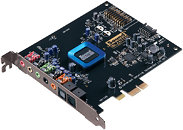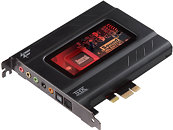Friday, September 2nd 2011

Creative Rolls Out Sound Blaster SoundCore 3D 'Quad-Core' PCIe Sound Cards
Alongside the Recon3D external audio device for PC, Mac, Xbox 360 and Playstation 3, Creative announced its latest line of PCI-Express sound cards. It's curtains for the X-Fi generation of sound cards that led Creative's pack through the second half of the last decade. Creative's newest sound card technology is called Sound Core3D. Unlike with X-Fi which continued the tradition of high-performance native (hardware) audio processing by making use of RISC processors on the card such as the CA20K series, with Sound Core3D "quad-core", the focus finally shifted to the set of DSPs (digital signal processors).
The "quad-core" moniker doesn't refer to there being four processing cores on the sound card, but a set of four DSPs, not necessarily hardware-accelerated, that work to give out the best audio. Two main DSP sets include Creative CrystalVoice and THX TruStudio Pro. THX TruStudio Pro is a DSP set that we're familiar with, some modern sound cards feature it, some motherboard vendors even pack it with their onboard HD audio solutions. THX TruStudio Pro provides THX TruStudio Pro Crystalizer, which works to improve clarity of lossy compressed audio, TruStudio Pro Surround creates a virtual 360 degree surround space that is touted to be better than the countless earlier attempts by various companies, at virtual surround. Smart Volume is a volume stabilizer that keeps in check abrupt volume spikes in games. Dialog Plus controls the mid frequencies to ensure the clearest voice dialog in games (cut-scenes or multiplayer voice chat). Lastly, Pro Bass is a bass compensation feature that works to restore lossy bass.The CrystalVoice DSP is another DSP that improves in-game voice chatter. Acoustic Echo Cancellation eliminates echos and talkback. Noise Reduction works to suppress background noise, sending through only the player's voice. Smart Volume stabilizes volume. FX allows users to morph their voice to remain anonymous.
Microsoft Windows NT 6 kernel, used in operating systems since Windows Vista and Server 2008, saw a relocation of the audio stack, that effectively made hardware audio processing useless, because there's no direct access to hardware using DirectSound. There still is the third-party OpenAL API, but it is greatly limited and doesn't keep up with the latest sound resolutions. For Creative to stay competitive in the sound card industry, it has to do what its younger competitors such as ASUS, Auzentech (to an extant), and HT Omega realized long back, which is focusing on high signal-to-noise ratio (sound fidelity), and DSPs. Today's system processors by Intel and AMD are fast enough to process several DSP layers without impacting on system performance.
Creative's new sound cards include the Sound Blaster Sound Core3D (base model), Sound Blaster Recon3D Fatal1ty Professional and Sound Blaster Recon3D Fatal1ty Champion. The SB Core3D is the base model, its PCB doesn't have any fancy EMI shield. It uses a simple PCI-Express audio processor that does away with most of the RISC processor components of the CA20K series audio processors. There's a rounded-square fancy-looking object in the middle that screams "SoundCore 3D". I suspect it's an EMI shield for the DAC under it. It features common HDA front-panel output, Fatal1ty Champion front-panel IO capability, and a common-looking set of 7.1 channel analog jacks next to TOSLINK digital input and output connectors.
The Recon3D Fatal1ty Professional ups the ante with a groovy looking EMI shield for the entire PCB, a red LED lighting, and a polycarbonate window. This card comes with a beam microphone that helps with the CrystalVoice technology. The Recon3D Fatal1ty Champion takes it a notch further with a front panel that fits into the 5.25"/3.5" exposed drive-bay, and provides some connectivity such as headphone out, volume control, and DSP control.
The "quad-core" moniker doesn't refer to there being four processing cores on the sound card, but a set of four DSPs, not necessarily hardware-accelerated, that work to give out the best audio. Two main DSP sets include Creative CrystalVoice and THX TruStudio Pro. THX TruStudio Pro is a DSP set that we're familiar with, some modern sound cards feature it, some motherboard vendors even pack it with their onboard HD audio solutions. THX TruStudio Pro provides THX TruStudio Pro Crystalizer, which works to improve clarity of lossy compressed audio, TruStudio Pro Surround creates a virtual 360 degree surround space that is touted to be better than the countless earlier attempts by various companies, at virtual surround. Smart Volume is a volume stabilizer that keeps in check abrupt volume spikes in games. Dialog Plus controls the mid frequencies to ensure the clearest voice dialog in games (cut-scenes or multiplayer voice chat). Lastly, Pro Bass is a bass compensation feature that works to restore lossy bass.The CrystalVoice DSP is another DSP that improves in-game voice chatter. Acoustic Echo Cancellation eliminates echos and talkback. Noise Reduction works to suppress background noise, sending through only the player's voice. Smart Volume stabilizes volume. FX allows users to morph their voice to remain anonymous.
Microsoft Windows NT 6 kernel, used in operating systems since Windows Vista and Server 2008, saw a relocation of the audio stack, that effectively made hardware audio processing useless, because there's no direct access to hardware using DirectSound. There still is the third-party OpenAL API, but it is greatly limited and doesn't keep up with the latest sound resolutions. For Creative to stay competitive in the sound card industry, it has to do what its younger competitors such as ASUS, Auzentech (to an extant), and HT Omega realized long back, which is focusing on high signal-to-noise ratio (sound fidelity), and DSPs. Today's system processors by Intel and AMD are fast enough to process several DSP layers without impacting on system performance.
Creative's new sound cards include the Sound Blaster Sound Core3D (base model), Sound Blaster Recon3D Fatal1ty Professional and Sound Blaster Recon3D Fatal1ty Champion. The SB Core3D is the base model, its PCB doesn't have any fancy EMI shield. It uses a simple PCI-Express audio processor that does away with most of the RISC processor components of the CA20K series audio processors. There's a rounded-square fancy-looking object in the middle that screams "SoundCore 3D". I suspect it's an EMI shield for the DAC under it. It features common HDA front-panel output, Fatal1ty Champion front-panel IO capability, and a common-looking set of 7.1 channel analog jacks next to TOSLINK digital input and output connectors.
The Recon3D Fatal1ty Professional ups the ante with a groovy looking EMI shield for the entire PCB, a red LED lighting, and a polycarbonate window. This card comes with a beam microphone that helps with the CrystalVoice technology. The Recon3D Fatal1ty Champion takes it a notch further with a front panel that fits into the 5.25"/3.5" exposed drive-bay, and provides some connectivity such as headphone out, volume control, and DSP control.


69 Comments on Creative Rolls Out Sound Blaster SoundCore 3D 'Quad-Core' PCIe Sound Cards
YOU TOO can sound like batman(or david keith <3)
:respect:
OpenAL is an option, but development is stagnant so it seems.
For a long time a lot of games developers have been using Miles Audio - they say the list on their website is a 'partial list' but its huge! Activision have used Miles Audio for so many of their games.
Screw creative, they deserve their near bankruptcy.
Not to worry though, I'm sure Auzentech will pick that "SoundCore" up at some point and deliver a monstrosity of a board with a ton of swappable parts on it...
I'm so over creative. The Xonar is way better than my X-Fi.
"The Recon3D Fatal1ty Champion takes it a notch further with a front panel that fits into the 5.25"/3.5" exposed drive-bay, and provides some connectivity such as headphone out, volume control, and DSP control."
really? like the old x-fi cards? no fucking standard hookups again?
i won't pay that much money for shit that won't work out of the box with my pc case's standard mic and headphone jack.
The quality is fine and the stability is unseen since the AWE32 days.
So I have no reason to change to this card. If only games could bring us a whole new audio experience!
Also the hardware is pointless when you look at theri drivers and how big of a piece of unstable crap they are.
Congrats creative on realizing that you are outdated.
8-bit, 16-bit, 24-bit....RESOLUTION!!! :laugh:
I cant helps myselfs
For example, look at Realtek. They supply a very large percentage of HD audio logic/solutions to motherboard manufacturers. The software is pretty straight forward and to put the icing on the cake they update their drivers usually every month. Creative releases a new "beta" driver for my X-Fi maybe once or twice a year.